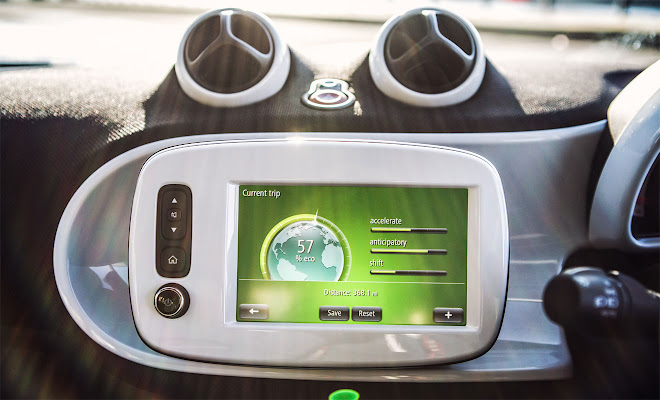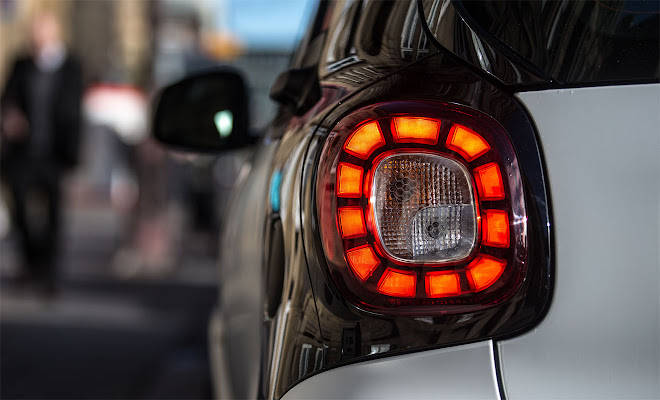by Phil Huff 
The Fortwo hasn’t had an easy ride, though. While often praised for its go-kart handling, I can think of few kind words about its go-kart comfort. To describe the ride as firm is a little of an understatement, and combined with a truly miserable semi-automatic gearbox it made life anywhere beyond the urban crawl more pain than pleasure.

Now there’s a new third-generation model, but is it a case of third time lucky for Smart? Mercedes, Smart’s parent company, has entered in to a partnership with Renault which means the new Mk3 Fortwo shares a lot of mechanical bits with the latest Twingo, which has helped keep development costs down for both manufacturers (not that you’d be able to tell from the Smart’s £11,125 minimum price tag). Co-operation has also freed up time and budget to make the new car a little bit Smarter.
Step from a Twingo straight into a Fortwo, and the level of extra engineering that has gone into the Smart is immediately apparent. There is additional soundproofing and a smoother, more refined ride thanks to suspension that is related, presumably quite distantly, to the undercarriage of the new Mercedes C-Class.

While there are similarities between Twingo and Smart, it feels as if the work done in Stuttgart has separated the two cars into very distinct products.
That engineering know-how has extended to the driving characteristics. Within the city limits it no longer feels like I’m lurching and jumping from one bump to the next, with the little Smart instead absorbing imperfections with a deftness that is surprising, given its tiny wheelbase. Skittishness has been replaced by zestiness, the Fortwo cutting a nimble dash through narrow urban streets.
Escaping the city and finding some open roads, I start to appreciate how much the Fortwo has grown up. The Smart’s famous black-cab-beating turning circle could have led to nervous behaviour on faster corners, but that suspicion couldn’t be further from the truth. Instead, the Fortwo feels so composed and confident you could almost forget you’re not in a much larger saloon.

Of course, the Fortwo is no sports car. Trying to eke out the last ounce of performance is likely to leave you tired and disappointed, but you can still make surprisingly swift progress across country thanks to the direct steering and a finely balanced chassis.
The rear-engined layout helps weight distribution, although with just 71bhp to play with from the 1.0-litre, three-pot petrol engine, there’ll be no tail-out fun or mini-Porsche 911 comparisons. But there is slick-shifting five-speed manual gearbox (or a proper six-speed, dual-clutch auto box) and an unexpected lightness of touch to the car that can make it a joy to drive.

An official CO2 score as low as 93g/km is also welcome, with a combined cycle rating of 68.9mpg.
Of course there are downsides. Being such a small car with tall, straight sides, crosswinds can interfere at times. Some clever crosswind-correcting electronic wizardry tries hard to keep you on the straight and narrow. The extraordinarily short wheelbase also tends to make the Smart feel a bit choppy if bumps arrive in quick succession, but for the most part it’s a genuinely good effort.
The Fortwo is still most at home in the city, though, thanks to its diminutive size. The new model remains just 2,695mm long, meaning you can still get away with parking nose-in to the kerb. And in this new car it’s the nose that has changed the most, given that it now has one. The stubby bonnet hides crash structures that modern lawmakers demand, which means the cabin has been pushed back a little compared to the outgoing Smart.

The interior does feel as if it has lost some space, and the staggered seating arrangement has gone. However, the new model is wider than before which frees up some much needed elbow and shoulder room. The end result is that my photographer (tall) and me (wide) could sit together in comfort without any issues at all.
The rest of the interior has a real premium feel to it, rivalling the quality of its bigger Mercedes-Benz siblings and representing a huge stride forward for Smart. Interesting surface details, including the option of bright fabric stretched across the dashboard, sit alongside high-tech equipment embedded in the centre console. It all sits well with that funky exterior.
The infotainment system deserves special praise for being easy to use and very effective – when it works. The system did crash on me while out on the road, though to be fair the car I was driving was a pre-production model.

Elsewhere there’s climate control, alloy wheels, five airbags and a multi-function steering wheel, even on the base model. That said, the base model Passion spec does cost around £2,000 more than its Renault Twingo relative.
Is the Fortwo worth the premium over a Twingo, despite losing two seats to the French alternative? It’s always going to be difficult to make a case for the Smart on purely financial terms, but this third-generation Fortwo has transformed the car from a niche also-ran to something that you could imagine using not just as a second car but as a daily driver.
It might have taken 15 years to arrive, but this feels like the car Smart should have been building from day one.


Smart ForTwo Mk3
Rating: stars
Good: impressive comfort and handling, big-car feel
Bad: just the two seats, swayed by crosswinds, not cheap
Price: from £11,125
It’s now fifteen years since Mercedes’ first attempt at rewriting the rule book on city car design. The result, the Smart-branded two-seater City Coupe, proved well suited to urban life. More than 100,000 of the tiny super-supermini have since found a home in the UK.Rating: stars
Good: impressive comfort and handling, big-car feel
Bad: just the two seats, swayed by crosswinds, not cheap
Price: from £11,125
The Fortwo hasn’t had an easy ride, though. While often praised for its go-kart handling, I can think of few kind words about its go-kart comfort. To describe the ride as firm is a little of an understatement, and combined with a truly miserable semi-automatic gearbox it made life anywhere beyond the urban crawl more pain than pleasure.

Now there’s a new third-generation model, but is it a case of third time lucky for Smart? Mercedes, Smart’s parent company, has entered in to a partnership with Renault which means the new Mk3 Fortwo shares a lot of mechanical bits with the latest Twingo, which has helped keep development costs down for both manufacturers (not that you’d be able to tell from the Smart’s £11,125 minimum price tag). Co-operation has also freed up time and budget to make the new car a little bit Smarter.
Step from a Twingo straight into a Fortwo, and the level of extra engineering that has gone into the Smart is immediately apparent. There is additional soundproofing and a smoother, more refined ride thanks to suspension that is related, presumably quite distantly, to the undercarriage of the new Mercedes C-Class.

While there are similarities between Twingo and Smart, it feels as if the work done in Stuttgart has separated the two cars into very distinct products.
That engineering know-how has extended to the driving characteristics. Within the city limits it no longer feels like I’m lurching and jumping from one bump to the next, with the little Smart instead absorbing imperfections with a deftness that is surprising, given its tiny wheelbase. Skittishness has been replaced by zestiness, the Fortwo cutting a nimble dash through narrow urban streets.
Escaping the city and finding some open roads, I start to appreciate how much the Fortwo has grown up. The Smart’s famous black-cab-beating turning circle could have led to nervous behaviour on faster corners, but that suspicion couldn’t be further from the truth. Instead, the Fortwo feels so composed and confident you could almost forget you’re not in a much larger saloon.

Of course, the Fortwo is no sports car. Trying to eke out the last ounce of performance is likely to leave you tired and disappointed, but you can still make surprisingly swift progress across country thanks to the direct steering and a finely balanced chassis.
The rear-engined layout helps weight distribution, although with just 71bhp to play with from the 1.0-litre, three-pot petrol engine, there’ll be no tail-out fun or mini-Porsche 911 comparisons. But there is slick-shifting five-speed manual gearbox (or a proper six-speed, dual-clutch auto box) and an unexpected lightness of touch to the car that can make it a joy to drive.

An official CO2 score as low as 93g/km is also welcome, with a combined cycle rating of 68.9mpg.
Of course there are downsides. Being such a small car with tall, straight sides, crosswinds can interfere at times. Some clever crosswind-correcting electronic wizardry tries hard to keep you on the straight and narrow. The extraordinarily short wheelbase also tends to make the Smart feel a bit choppy if bumps arrive in quick succession, but for the most part it’s a genuinely good effort.
The Fortwo is still most at home in the city, though, thanks to its diminutive size. The new model remains just 2,695mm long, meaning you can still get away with parking nose-in to the kerb. And in this new car it’s the nose that has changed the most, given that it now has one. The stubby bonnet hides crash structures that modern lawmakers demand, which means the cabin has been pushed back a little compared to the outgoing Smart.

The interior does feel as if it has lost some space, and the staggered seating arrangement has gone. However, the new model is wider than before which frees up some much needed elbow and shoulder room. The end result is that my photographer (tall) and me (wide) could sit together in comfort without any issues at all.
The rest of the interior has a real premium feel to it, rivalling the quality of its bigger Mercedes-Benz siblings and representing a huge stride forward for Smart. Interesting surface details, including the option of bright fabric stretched across the dashboard, sit alongside high-tech equipment embedded in the centre console. It all sits well with that funky exterior.
The infotainment system deserves special praise for being easy to use and very effective – when it works. The system did crash on me while out on the road, though to be fair the car I was driving was a pre-production model.

Elsewhere there’s climate control, alloy wheels, five airbags and a multi-function steering wheel, even on the base model. That said, the base model Passion spec does cost around £2,000 more than its Renault Twingo relative.
Is the Fortwo worth the premium over a Twingo, despite losing two seats to the French alternative? It’s always going to be difficult to make a case for the Smart on purely financial terms, but this third-generation Fortwo has transformed the car from a niche also-ran to something that you could imagine using not just as a second car but as a daily driver.
It might have taken 15 years to arrive, but this feels like the car Smart should have been building from day one.




